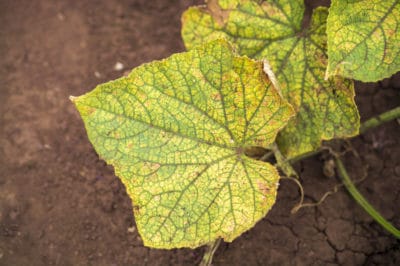Fungal Cucumber Disease
Given the opportunity, these fungal diseases will happily decimate your cuke crop:
- Powdery or downy mildew
- Alternaria or Cercospora leaf spot
- Anthracnose
- Gummy stem blight
Powdery Mildew
Cuke leaves with powdery mildew look like they’re coated in talcum powder. Over time, they become grayish-brown and dry. The fungus usually attacks cukes with inadequate sun. It’s most active in dry, humid weather.
Downy Mildew
Yellow spots eventually engulfing cuke leaves with brown lesions signal downy mildew infection. Like powdery mildew, the fungus thrives in warm, humid or moist conditions.
Preventing Mildew Disease
For economical and eco-friendly prevention:
- Allow 3 to 5 feet (0.92 to 1.5 meters) between trailing cukes and 1 foot (0.3 meters) between trellised ones.
- Give cukes at least 5 hours of daily sun.
- Water from beneath to keep leaves dry. Trellsing makes this much easier.
- Promptly snip off mildewed leaves. Dispose of them in sealed bags.
Expert gardener’s tip: For organic powdery mildew prevention, spray your cukes with a solution of 1 part milk to 9 parts water when conditions are right for an outbreak. Applied on a sunny day every two weeks, it stops new infections.
Leaf Spots, Anthracnose and Gummy Stem Blight
Identify these fungi by their different leaf spots:
- Alternaria produces tan spots that spread up to 1.5 inches (3.8 cm).
- Cercospora spots start out blackish before turning yellow with black margins.
- Anthracnose peppers leaves with yellow spots that blacken.
- Gummy stem blight starts as tan spots that spread into dead, wedge-shaped patches The patches sometimes ooze thick goo.
#Leaf Spot, Anthracnose and Gummy Stem Blight Control
Remove and destroy affected cukes. Prevention includes proper spacing, watering from beneath, thinning out excess foliage and regular weeding.
Cucumber Mosaic Virus
Tiny, sap-sucking aphid insects transmit this disease to cucumbers. Affected leaves develop yellow spots, streaks and veins, and fruits become mottled or warty. Contaminated garden tools also spread it. The virus strikes as soon as an infected insect feeds, so spraying won’t work. Healthy plants withstand the worst of the damage.
Bacterial Wilt
If your cukes appear dried and wilted no matter how well you water, suspect bacterial wilt. Yellowish-green, striped or spotted cucumber beetles spread the disease from plant to plant.
Bacterial Wilt Control
Remove and destroy infected cukes. Cover the remaining ones with protective row covers. They’re made of ultra-light, translucent fabric that allows air, sun and moisture in while keeping the beetles out.
